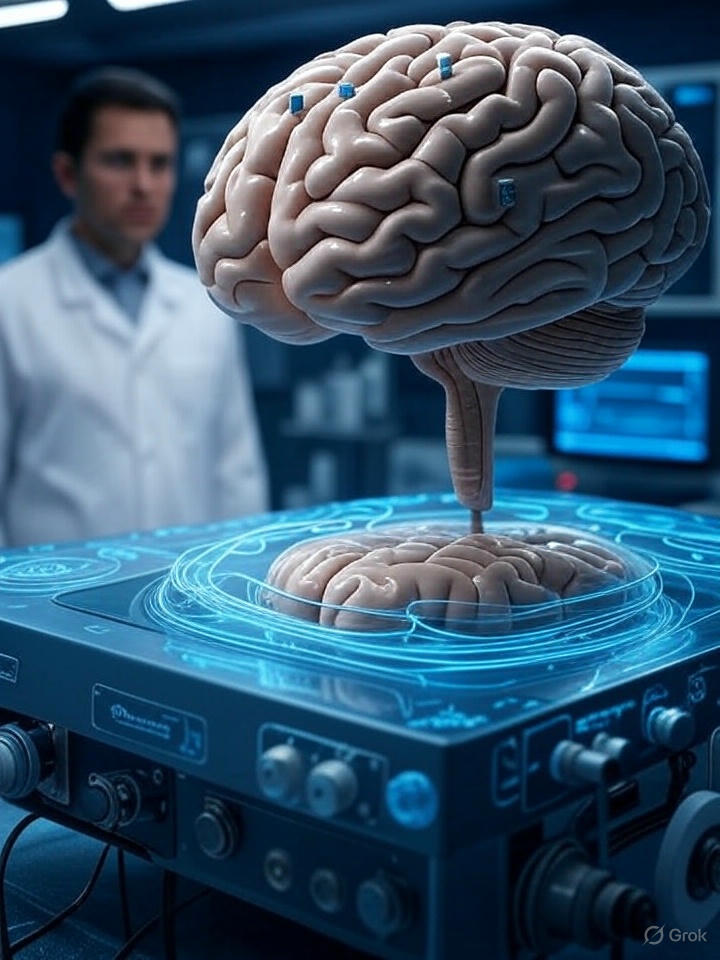Key Points
- Chinese researchers have developed a brain-spinal interface (BSI) that helps paralyzed patients regain movement and sensation.
- The technology uses small brain and spinal implants with AI to bypass damaged neural pathways.
- Clinical trials in 2025 showed patients walking within days, with some sensory recovery.
- It may potentially be adapted to treat facial paralysis, restoring facial movements and sensations.
- Challenges include adapting the technology for facial nerves and ensuring precision for natural expressions.
What is the BSI Technology?
In 2025, scientists from Fudan University in Shanghai introduced a brain-spinal interface (BSI) that allows people with spinal cord injuries to move again. This technology involves implanting tiny chips in the brain and spinal cord to reconnect the brain’s signals to paralyzed limbs. Using artificial intelligence (AI), the system translates brain signals into movements, helping patients walk and even feel sensations like warmth.
How Does It Help Paralyzed Patients?
In trials at hospitals in Shanghai and Hangzhou, patients who had been paralyzed for years regained leg movement within 24 hours of a four-hour surgery. Some could walk with support within two weeks, and one patient walked independently. The technology also restored sensations, like bladder control, suggesting it could repair nerve connections over time.
Could It Help with Facial Paralysis?
Facial paralysis, caused by conditions like Bell’s palsy or stroke, affects facial expressions and functions like speaking or eating. The BSI’s ability to capture brain signals and stimulate nerves could potentially be adapted to activate facial muscles or nerves, helping patients smile or blink again. It might also restore sensations like taste. However, this would require significant changes to target facial nerves instead of spinal ones, and more research is needed.
What Are the Challenges?
Adapting BSI for facial paralysis is complex because facial movements are controlled by different nerves and require precise coordination for natural expressions. The technology is still new, and scaling it for widespread use or facial applications will take time and further testing to ensure safety and effectiveness.
Brain-Spinal Interface Technology: A Breakthrough in Paralysis Treatment and Its Potential in Maxillofacial Applications
Introduction
In early 2025, Chinese researchers from Fudan University in Shanghai unveiled a groundbreaking brain-spinal interface (BSI) technology, offering new hope for patients with spinal cord injuries (SCI). This “triple-integrated” system, involving brain and spinal implants coupled with artificial intelligence (AI), has enabled paralyzed patients to regain mobility and sensation, marking a significant leap in neurorestorative medicine. This blog reviews the BSI technology, its clinical achievements, and explores its potential future applications in the maxillofacial region, particularly for facial paralysis, a condition affecting millions globally.
The BSI Technology: A News Review
The BSI system, developed entirely in China, comprises two small electrode chips (approximately 1mm in diameter) implanted in the brain’s motor cortex and a stimulator chip in the spinal cord. These components create a “neural bypass” that captures motor intention signals from the brain, decodes them using AI, and delivers electrical pulses to spinal nerves below the injury site, effectively restoring communication between the brain and paralyzed limbs (Xinhua, 2025).
Clinical trials conducted between January and March 2025 at Zhongshan and Huashan Hospitals in Shanghai demonstrated remarkable results. Four patients with complete SCI, paralyzed for one to seven years, underwent minimally invasive surgery lasting about four hours. Within 24 hours, all patients achieved leg movement, with some regaining independent leg control and walking over five meters with support within two weeks (Fudan University, 2025). Notably, patients reported restored sensations, such as warmth and bladder control, suggesting neural remodeling beyond motor recovery. For instance, a patient named Lin, paralyzed for two years after a fall, could lift both legs within hours and walk with assistance by day 15 (China Daily, 2025).
A separate trial in Hangzhou at Zhejiang University’s Second Affiliated Hospital in March 2025 further validated the technology. A 61-year-old paraplegic patient, implanted with a 16-contact electrode and a wireless pulse generator, achieved independent walking within two weeks, alongside improved sensory and bodily functions (Zhejiang University, 2025). Unlike Western approaches, such as Neuralink’s brain-computer interfaces, which often rely on external devices, the Chinese BSI is fully implantable and less invasive, using fewer electrodes. The system aims to foster long-term neural repair, potentially allowing patients to reduce device dependency after three to five years of rehabilitation (Xinhua, 2025).
The technology addresses a critical global health challenge, with 3.74 million SCI patients in China and 20 million worldwide (WHO, 2023). However, challenges remain, including real-time signal decoding, electrode durability, and scalability for widespread clinical use. The BSI’s success underscores China’s growing leadership in neural interface technology, setting a new benchmark for neurorestorative innovation.
Table 1: Key Features of the Chinese BSI Technology
| Feature | Description |
|---|---|
| Components | Two 1mm electrode chips in the brain’s motor cortex, one stimulator in the spinal cord |
| Function | Creates a neural bypass to restore brain-limb communication |
| AI Role | Decodes brain signals for precise stimulation |
| Surgical Time | Approximately 4 hours, minimally invasive |
| Clinical Outcomes | Leg movement within 24 hours, walking with support in 2 weeks, sensory recovery |
| Unique Aspect | Fully implantable, fewer electrodes than Western counterparts |
Potential Applications in the Maxillofacial Region
While the BSI technology is currently tailored for SCI, its underlying principles—neural signal capture, AI-driven decoding, and targeted stimulation—hold transformative potential for maxillofacial applications, particularly in treating facial paralysis. Facial paralysis, caused by conditions like Bell’s palsy, stroke, trauma, or tumors, affects approximately 1 in 5,000 people annually and impairs facial expressions, speech, and eating, significantly impacting quality of life (De Diego et al., 1999). Below, we explore how BSI could be adapted for maxillofacial applications in the future.
1. Restoration of Facial Motor Function
Facial paralysis often results from damage to the facial nerve (cranial nerve VII) or motor cortex areas controlling facial muscles. A modified BSI could capture brain signals from the motor cortex responsible for facial movements (e.g., smiling, blinking) and transmit them to a stimulator implanted near the facial nerve or directly on muscles like the orbicularis oculi or zygomaticus major. This approach would bypass damaged neural pathways, restoring voluntary control over facial expressions. For central causes of paralysis, such as stroke, where brain signals are intact but not transmitted, BSI could be particularly effective (Hohman & Hadlock, 2014).
2. Sensory Recovery
The Chinese BSI trials reported sensory restoration in SCI patients, suggesting neural plasticity and remodeling. In facial paralysis, sensory deficits, such as loss of taste or facial sensation, are common, particularly in Bell’s palsy or post-surgical cases. A BSI adapted for the maxillofacial region could stimulate sensory branches of the facial or trigeminal nerve, potentially restoring sensations critical for functions like chewing or speaking. This would require precise electrode placement and AI algorithms tailored to the complex innervation of the face (Roostaei et al., 2016).
3. Precision in Complex Facial Movements
Facial muscles require fine motor control for coordinated movements, unlike the larger muscle groups targeted in SCI. The BSI’s AI-driven signal decoding could be adapted to map intricate facial expressions, enabling precise stimulation of muscles for natural movements, such as symmetrical smiling or eyelid closure. This would be a significant improvement over current neuromodulation techniques like transcutaneous electrical nerve stimulation, which lack specificity (Frigerio et al., 2015).
4. Minimally Invasive Interventions
The BSI’s minimally invasive design, using small electrode chips, is well-suited for the delicate maxillofacial region, where surgical risks must be minimized to avoid cosmetic or functional complications. Smaller implants could reduce tissue damage and improve patient acceptance compared to traditional nerve grafts or muscle transfers (Hontanilla & Marre, 2013).
5. Long-Term Neural Repair
The BSI’s potential to promote neural remodeling through prolonged use could be a game-changer for facial paralysis. By stimulating neural pathways over time, the system might strengthen or regenerate connections between the brain and facial muscles, reducing dependency on implants. This aligns with the Chinese BSI’s goal of enabling device-free function after years of rehabilitation (Xinhua, 2025).
Challenges in Maxillofacial Applications
Adapting BSI for facial paralysis faces several hurdles. First, facial muscles are controlled by cranial nerves, not spinal ones, requiring redesigned electrode placements and stimulation protocols. Second, the diversity of facial paralysis causes (peripheral vs. central) necessitates tailored approaches; for instance, peripheral nerve damage in Bell’s palsy may require direct muscle stimulation, while stroke-related paralysis might focus on cortical signals. Third, the cosmetic and functional demands of facial movements require high precision to avoid unnatural expressions. Finally, scaling the technology for maxillofacial use would require extensive clinical trials to ensure safety and efficacy in the facial region (Hohman & Hadlock, 2014).
Table 2: Potential Maxillofacial Applications of BSI Technology
| Application | Description | Challenges |
|---|---|---|
| Facial Motor Restoration | Stimulate facial nerve/muscles to restore expressions like smiling or blinking | Precise electrode placement for cranial nerves |
| Sensory Recovery | Restore taste or facial sensation via neural stimulation | Complex facial innervation requires tailored AI algorithms |
| Precision in Movements | AI-driven decoding for natural, coordinated facial expressions | High precision needed to avoid unnatural expressions |
| Minimally Invasive Design | Small implants reduce surgical risks in the facial region | Ensuring cosmetic and functional outcomes |
| Long-Term Neural Repair | Promote neural remodeling to reduce device dependency | Long-term clinical trials needed for safety and efficacy |
Conclusion
The Chinese BSI technology represents a monumental advancement in treating paralysis, offering rapid motor and sensory recovery for SCI patients. Its potential adaptation for maxillofacial applications, particularly facial paralysis, could revolutionize treatment by restoring motor and sensory functions with unprecedented precision. While significant research is needed to overcome technical and anatomical challenges, the BSI’s AI-driven, minimally invasive approach holds promise for transforming maxillofacial medicine. As neural interface technologies evolve, interdisciplinary collaboration will be key to unlocking their full potential for facial paralysis patients.
Key Citations
- China Daily: Brain-spinal interface helps paralyzed patients walk
- Epidemiology of facial palsy
- Surface electromyography for facial muscle stimulation
- Fudan University: Brain-spinal interface breakthrough
- Etiology, diagnosis, and management of facial palsy
- Advances in facial reanimation
- Sensory recovery in facial nerve paralysis
- WHO: Spinal cord injury fact sheet
- Xinhua: China’s brain-spinal interface restores mobility
- Zhejiang University: Closed-loop spinal neural interface
- www.smilemaker.in

